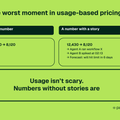Insights straight to your inbox
Join 10,000+ subscribers getting the latest insights on AI monetization.


Most people see the polished interface. Clean layouts. Smooth flows. Details that look inevitable.
What they don’t see is the chaos that built it.
My brain doesn’t work in straight lines. It works like spaghetti. Fragments tangle - a sketch in Figma, a half-baked ChatGPT prompt, a broken prototype still open in Replit or Lovable. By 3 AM I’ve got nine tools open, three versions of the same idea colliding, tabs I should have closed hours ago. It looks like a mess, but it’s momentum. Patterns start to emerge. Breakthroughs hide in the noise.
I design in that chaos. Not because I have to, but because I thrive in it. And because moving at startup speed demands it. If you are chasing perfect, you are already late.
This isn’t about being messy for the sake of it. It’s about unlearning the way we were taught to design, because that way doesn’t work at the speed startups move.

I've worked at places that taught me opposite lessons. IBM's Design Thinking gave me discipline - loops, hills, user outcomes, the whole system. Anaplan showed me how to scale that discipline post-IPO with serious research and design systems. Sentieo was the scramble phase where I learned design could unify everything and give a company its backbone. But each time, the foundation that made us good also made us slow.
AlphaSense was the wake-up call - bigger teams, smaller influence, frameworks for their own sake, research that meant paying people to pretend to care. hx stripped all that back to high-stakes clarity where you couldn't fake it.
The pattern became obvious: every place rewarded polish over progress, but chaos always shipped.
Now I know what to break to move faster.
At Paid, design is not a phase or a handoff. It is a loop. Messy, fast, purposeful.
Here’s how it actually works:
It’s not linear. It’s not clean. But it’s alive. And that’s why it works.
Most first versions are wrong. Good. Wrong gets you to right faster than polish ever will.
And design isn’t siloed. Everyone is in the loop. Engineers design when they ship code. I design when I break flows in Figma, Replit, Lovable, or even Bolt (which never works, but I’m still a believer). Customers design when they stumble through and tell us it sucks.
From the outside it looks chaotic. Inside, it’s our speed advantage.
That is Paid’s DNA: messy, fast, but with intent. We don’t design to keep things neat. We design to ship faster, learn faster, and earn trust in what we’re building.
The tools keep me moving. Music blasting, YouTube in the background...
Figma. ChatGPT. Cursor. Replit. Gemini. Lovable. MidJourney. Sora. Veo. Perplexity. Bolt. Some nights it’s all of them at once, tabs stacked to infinity.
They don’t make decisions. They give me fifty variations so I can throw forty-nine away before lunch. AI doesn’t have taste. But it has tireless execution. I supply the judgment. They supply the speed.
Chaos isn’t careless. Chaos is how you learn faster than your competition can copy.
Fast doesn’t mean careless. The faster you ship, the more details matter.
Typography: Inter for interface text, JetBrains Mono for code and data. Tested across seventeen combinations. Inter works at 12px on mobile and 48px in a boardroom. JetBrains Mono makes numbers scannable in walls of data. That isn’t aesthetic. That’s business. A CFO parsing billing at 7am without coffee: that is trust.
Colors: a system built to scale across light, dark, and high contrast. Error red that warns without panic. Success green that feels earned, not patronizing. Handle revenue? These details decide if people trust you or churn.
Icons: Material Symbols. Not because they are beautiful (they are not) but because they are obvious. Nobody wants to decode your clever custom icons. They just want to find “Settings” and get on with it. Every second spent decoding design is a second they’re not getting value.
All of these decisions come together in Onyx: Paid’s design system.
Onyx is not just a library of tokens and components. It is the foundation that unifies typography, color, motion, and states into a system that scales as fast as we move. Chaos creates the concepts. Onyx locks them in. That’s how we stay fast without breaking trust.
These are not design flourishes. They are revenue decisions.
This way of working is not for everyone. If you need comfort, polish, or perfect roadmaps, you will hate it here.
At our speed, perfect is poison. Clean kills. Process drags.
We don’t wait. We don’t polish. We ship. We learn. We move.
Chaos is not noise. Chaos is fuel. It is the unfair advantage.
Design is not decoration. Design is the architecture. It is how the thing stands up when everything else is breaking.
So choose: do you want the illusion of tidy design for yesterday’s problem, or the chaos that actually wins today?
We chose chaos. And that’s why Paid will win.
Join 10,000+ subscribers getting the latest insights on AI monetization.



Price smarter. Protect margins. Grow revenue.